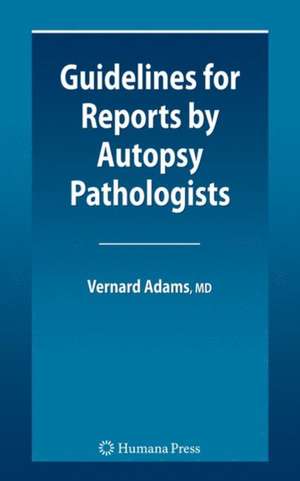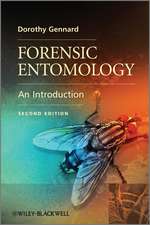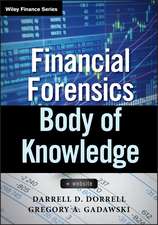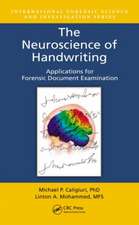Guidelines for Reports by Autopsy Pathologists
Autor Vernard Irvine Adamsen Limba Engleză Hardback – 25 iul 2008
| Toate formatele și edițiile | Preț | Express |
|---|---|---|
| Paperback (1) | 576.58 lei 6-8 săpt. | |
| Humana Press Inc. – 5 noi 2010 | 576.58 lei 6-8 săpt. | |
| Hardback (1) | 780.82 lei 6-8 săpt. | |
| Humana Press Inc. – 25 iul 2008 | 780.82 lei 6-8 săpt. |
Preț: 780.82 lei
Preț vechi: 952.22 lei
-18% Nou
Puncte Express: 1171
Preț estimativ în valută:
149.41€ • 156.56$ • 123.51£
149.41€ • 156.56$ • 123.51£
Carte tipărită la comandă
Livrare economică 11-25 aprilie
Preluare comenzi: 021 569.72.76
Specificații
ISBN-13: 9781603274722
ISBN-10: 1603274723
Pagini: 148
Ilustrații: XV, 128 p.
Greutate: 0.41 kg
Ediția:2008
Editura: Humana Press Inc.
Colecția Humana
Locul publicării:Totowa, NJ, United States
ISBN-10: 1603274723
Pagini: 148
Ilustrații: XV, 128 p.
Greutate: 0.41 kg
Ediția:2008
Editura: Humana Press Inc.
Colecția Humana
Locul publicării:Totowa, NJ, United States
Public țintă
Professional/practitionerCuprins
Preface.- Acknowledgement.- Part I. Autopsy protocol.- Purpose, structure, and organization.- Purpose.- Structure.- Organization.- Measurements.- Diagnostic terms.- External Examination.- Inventory of parts.- Clothing and surface evidence.- Identifying Features.- Signs of death.- Organization of external findings.- Therapy.- Organ and tissue dnation.- Wounds by type.- General organization.- Outside-in.- Paragraphs.- Impact wounds.- Blade wounds.- Hanging.- Firearm wounds.- Burns and fire deaths.- Wounds by organ.- Measurements.- Bones: General.- Skull and Dura.- Ribs.- Long bones and pelvis.- Vertebrae.- Ligaments, joints and muscle.- Body cavities.- Aortic lacerations.- Heart.- Central nervous system.- Lungs.- Liver.- Spleen.- Internal examination.- Autopsy procedures.- Wounds, therapy, and donations.- Body cavities.- Heart and great vessels.- lungs.- Liver, bile ducts, gallbladder and pancreas.- Reticuloendothelial system.- Genitourinary system.- Endocrine organs.- Digestive organs.- Musculoskeletal system.- Neck.- Head.- Tumors.- Part II. Opinion reports.- The logic of opinion formation.- Definitions of cause, mechanism, and manner.- Global approach.- Synthesis of mechanism, cause, and manner.- Competing diseases and injuries.- Degree of certainty.- Dignosis in tabular format.- Purpose.- Structure.- Diagnosis or finding?- What to include.- Cause of death as diagnosis.- Completeness and etiologic specificity.- Diagnosis in Narrative Format: The Summary and opinion report.- Purpose.- Structure.- History.- Autopsy Findings.- Opinions.- Part III. Other reports.- Ancillary laboratory reports.- Integration and investigation by pathologist.- Purpose.- Structure.- Case identification.- Background Information.- Environment.- Body.- Actions Taken.- Animal bones.- Purpose.- Structure.- Content.- Part IV. Style.- Construction.- Sentences.- Paragraphs.- Abbreviations.- Parentheses.- Adjectives.- Verbs.- Natural indexing.- Dictating to avoid editing.- Attorneys’ rules ofconstruction.- Inserting minor opinions.- Word Order.- Terminology.- Anatomical Terminology.- Latin and Greek.- Slang.- Brand names.- General Terminology.
Recenzii
From the reviews:
"Dr. Adams … describes how an autopsy report should be organized, what should be included and excluded, how to describe the external and internal examinations, including the proper way to describe wounds and disease states of individual organs, and how to formulate opinions. … This book would logically seem to be intended for the beginning pathologist, pathology resident or medical student, but should also be included in the library of any autopsy pathologist as a valuable reference." (Douglas Posey, Forensic Science, Medicine, and Pathology, December, 2008)
"This concise manual describes how to write autopsy reports, including how to describe disease and injury, form opinions, and communicate effectively with families and physicians. … practicing autopsy pathologists and forensic pathologists also will find this an excellent reference to have on hand. … This is a very useful book for any pathologist performing autopsies … especially for pathologists in training who are just learning how to report autopsy findings." (Katie L. Dennis, Doody’s Review Service, August, 2009)
"Dr. Adams … describes how an autopsy report should be organized, what should be included and excluded, how to describe the external and internal examinations, including the proper way to describe wounds and disease states of individual organs, and how to formulate opinions. … This book would logically seem to be intended for the beginning pathologist, pathology resident or medical student, but should also be included in the library of any autopsy pathologist as a valuable reference." (Douglas Posey, Forensic Science, Medicine, and Pathology, December, 2008)
"This concise manual describes how to write autopsy reports, including how to describe disease and injury, form opinions, and communicate effectively with families and physicians. … practicing autopsy pathologists and forensic pathologists also will find this an excellent reference to have on hand. … This is a very useful book for any pathologist performing autopsies … especially for pathologists in training who are just learning how to report autopsy findings." (Katie L. Dennis, Doody’s Review Service, August, 2009)
Textul de pe ultima copertă
Traditionally, pathology residents have learned how to write autopsy reports by trial-and-error, with oral feedback from local mentors. Now, pathologists and pathologists in training throughout the English-speaking world have access to a manual that describes what should be in an autopsy report, how to organize the material, and what the purposes are. Guidelines for Reports by Autopsy Pathologists lists numerous bad habits to avoid, and offers examples of effective report construction. It covers not only how to describe diseases and injuries, but also how to formulate and write opinions. As a supplement, Guidelines for Reports by Autopsy Pathologists also contains recommendations on record retention schedules for medical examiners (not everything needs to be saved in perpetuity), and how to formulate opinions for death certificates. Aimed at pathologists in training, Guidelines for Reports by Autopsy Pathologists will alos benefit the seasoned pathologists who want to improve their reports.
Caracteristici
To help the autopsy pathologist clearly communicate reports Emphasizes troublesome topics














